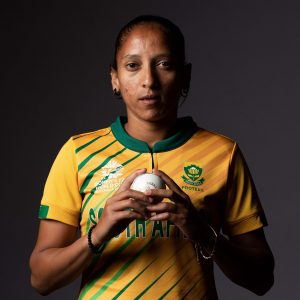Covid-19 causes setback for women’s cricket
The future looks bleak for the Proteas Women with the pandemic biting into gains made domestically and internationally. It doesn’t help that the South African government is failing to support them.…
Author:
2 September 2020

Women’s cricket, in South Africa and beyond its borders, faces an increasingly uncertain future. The game has made significant strides in the past few years, growing into a standalone attraction. But the Covid-19 pandemic and lockdown threatens to erode much of that progress.
The players have experienced prolonged inactivity during the lockdown. But it is the uncertainty about when next they will get a chance to play that worries respected cricket broadcaster Natalie Germanos. “It is very concerning, especially as no one can actually give a timeline as to when there may be a return to normality,” she told New Frame recently.
There is a tour of India pencilled in. But the rate of infection in the second most populous country in the world, plus a lack of support from the South African government, means it may be doomed.
Germanos has spent more time than most with the Proteas Women in the past few years, commentating around the world as they grew to become one of the most respected international women’s outfits. She knows where they stand in the world and how important it is to retain that status.
Related article:
“They have become one of the top teams in the world, and a look at what they have produced over the last few years confirms that,” said Germanos. “Not just in the T20 World Cup at the start of the year but the tour of New Zealand, where they won the ODI [one-day international] series to confirm their participation in the next World Cup. To do that away, against a tough opposition, just shows how far they have come. But you need to keep playing to maintain that reputation.”
Like many involved in the women’s game, Germanos was saddened by the recent decision to deny the side permission to travel to an eagerly anticipated trip to the United Kingdom. The Department of Sports, Arts and Culture did not respond to questions about why it wouldn’t allow the team to go to England, instead referring New Frame to a press release that offered no clarity on the matter.
“It would have been extremely frustrating for the team, because that would have been the first bit of cricket in a long while. They have had a good camp, after a very tough few months. They are a very close-knit unit, so that time together [playing] again would have been a massive relief for everyone,” said Germanos.
South Africa’s lack of faith
The camp was supposed to prepare the squad for a bio-secure visit to the UK, where their English counterparts were awaiting them with much anticipation. They, too, have been starved of cricket and know only too well that South Africa would have provided excellent competition.
“I think the ECB [England and Wales Cricket Board] must be commended for being able to provide us with some cricket to watch. It is at a huge financial cost to themselves, with chartered flights, extra-secure venues, and they are one of the few cricketing countries in the world that can foot that bill,” said Germanos.
The West Indies and Pakistan have visited England without incident. And the Australian men’s team left Perth on 23 August, headed for quarantine and then a limited-overs series. England has shown itself able to manage cricket safely and that assurance adds to the frustration of the department denying the South African women’s team their tour.
“Australia are coming from parts of the country that are under very strict lockdown restrictions, but they still made a plan. The South African women would have been in Derby, and everything was in place. Government obviously has its rules, and those have to be respected,” sighed Germanos.
The implications for the Proteas Women go far beyond the lack of on-field action, however. A tour overseas acts as a pivotal financial boost for a squad that earns nowhere near what their male counterparts make in a year.
Related article:
“I would liken a woman missing out on a tour overseas to a male player not going to the Indian Premier League [IPL] for a season,” said Germanos. “There are 14 contracts among the women, but they are nowhere near what the men earn. A lot of women have to take on an extra job in order to make ends meet, so the match fees and allowances that come with a tour of this nature would have meant a lot to players on the fringes of the squad.”
Even those who enjoy a higher profile are feeling nervous about their financial future. “There have also been some very interesting South African signings for the upcoming Women’s Big Bash League, with Lizelle Lee and Laura Wolvaardt also looking forward to turning out,” said Germanos.
Moving backwards after huge strides
Given where the women’s game had gone in recent years, with sold-out World Cup finals, record attendances and greater-than-ever crowd participation and recruiting, the Covid-19 pandemic has truly been a significant hiatus.
“You worry about the impact of a sustained break internationally. In terms of players, the older ones may be forced into an exodus, while youngsters trying to establish themselves may face a year without any cricket. No one knows how long the current state can go on for and, unfortunately, very few countries can afford the bio-secure bubbles that are currently hosting matches,” said Germanos.
“The loss of fans for the game is also a real issue. The modern fan has a very short attention span, so not having a product in front of them for an extended period is a worry. With fans going, then sponsors become a worry, and that hits the game financially.”
For a long time, women’s cricket has been the Cinderella in rags compared with the money and attention-flush male version of the game. But the Australian model and approach to women’s cricket has shown there is another way. The country’s players, armed with incredible on-field success, earn far more than their counterparts elsewhere in the world.
Related article:
For now, South Africa’s women can only dream of earning those figures. And Cricket South Africa firing chief executive Thabang Moroe on 27 August after a lengthy suspension is a further setback, as Moroe was in favour of women being paid the same as men and raising the profile of the women’s game.
Moroe’s suspension seems like a long time ago now. But so, too, does the last time that the Proteas Women played a game. Their tour to the West Indies was hit by the pandemic, and the Women’s Cricket World Cup next year has already been postponed.
There are lots of questions and no answers, and many will watch with interest to see what permissions and privileges the men’s team receive in the weeks to come. They are scheduled to go to the United Aarab Emirates for a series against India, before a large South African contingent heads to an IPL campaign that will also be hosted in the desert.
Should they get the green light – and there will be significant pressure for the Proteas to go – it will only reinforce the ugly side of the Cinderella narrative, according to which she was expected to stay home and clean the house while her relatives went to the ball.
Sadly for women’s cricket in South Africa, it doesn’t look likely that a fairy godmother will swoop in with a hearty dose of hope.
More than that, the future of the whole game in South Africa is increasingly under threat. Central to the issues facing cricket is an administration with little or no prior experience in the game. It is a symptom that is shambolically common in South African sport administration.
The measures that CSA have committed to with the sport ministry were presented by chairperson of the transformation committee, Eugenia Kula-Ameyaw, an individual who recently told an online press conference that cricket is not something she watches because it takes too long. Indeed, there was an urgency to wrap up the lunchtime press conference, so that the individual could go “back to sleep”.
For men and women involved in the game, that is an astonishing set of admissions. The game must always come first. Before cronyism, corruption, window-dressing and political points-scoring, the game and those who serve it honestly must come first.
As cricket burns, it needs strong and dedicated leadership whose prime motivation is to get the game to an infinitely better place than the helpless one it currently occupies.



